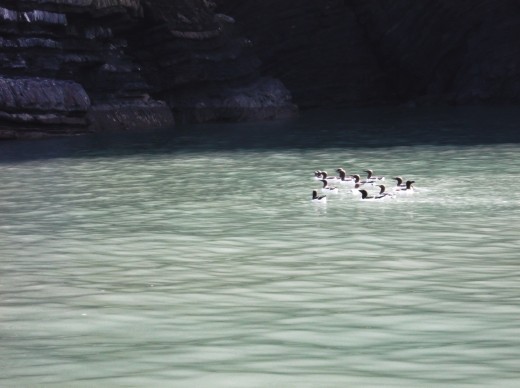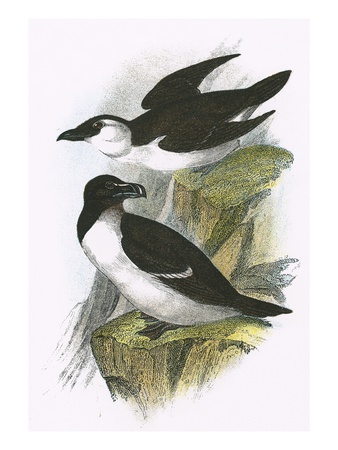During a recent trip to New Quay, South West Wales, I was tempted by a bill board I'd spotted in the harbour offering boat trips around the bay, with the intention of spotting dolphins, pourposies and seals. It was during this boat trip that I first came across the most intriguing of birds; the Razorbilled bird.
The noise from the diesel engine of the boat could not drown the sonics from the curious avian life circling us. Initially, I was under the impression that the birds bobbing on the surface of the water were ducks, that is, until I noticed that some of them were literally diving into the water and remaining beneath the surface for quite some time.










 A Colorful Journey: Comparing and Contrasting Mexican Folk Art With Polish Folk Arton 09/05/2024
A Colorful Journey: Comparing and Contrasting Mexican Folk Art With Polish Folk Arton 09/05/2024
 Exploring Traditional Japanese Tapestry Landscape Art: A Window into Nature’s Serenityon 09/01/2024
Exploring Traditional Japanese Tapestry Landscape Art: A Window into Nature’s Serenityon 09/01/2024
 Are Border Collies Really the Smartest Dog Breed?on 08/20/2024
Are Border Collies Really the Smartest Dog Breed?on 08/20/2024
 A Writer's Guide To Wizzley- A Gem of A Bookon 04/10/2013
A Writer's Guide To Wizzley- A Gem of A Bookon 04/10/2013



Comments
Greenlander Inuits integrate air, land and sea animals in their cuisine.
Unfortunately, those North-American Arctic and immediately sub-Arctic preferences put threatened seals and whales into that cuisine, which previously resulted in extinct-ing great auks.
Another such bird life with whom Greenlander Inuits regale their cuisine reduces razorbill numbers.
What would you select from a table set with roast duck, grouse, lamb, musk, pork, razorbill and reindeer? I wouldn't take any unless they otherwise would be tossed!
Razorbilled birds can be found in such environments as montane Greenland and Iceland.
The two above-mentioned islands distance perhaps 186 miles (299.337984 kilometers) one from the other.
Mightn't an extended razorbill family make an educationally entertaining, entertainingly education children's story?
Razorbills breed perhaps most safely, most successfully in Greenland and Iceland and on the Faroe Islands.
It's a question of less development intruding upon razorbill food webs, habitats and nests.
Might you have seen Greenland-manifesting razorbills?
Greenland-occurring razorbills offer quite a natural observation what with no inter-city, -town or -village roads overwhelming razorbill occupancies!
Thank you for your comment below, in answer to my previous observation and question.
Author Ragnar Jónasson (my favorite along with Kate Mosse, describes ledge-dwelling razorbills who domicile in a remote domain darkened by such a dastardly deed as one perpetrator driving one victim over the razorbill-nest ledge.
Might you have read any mysteries by the aforementioned author, who masters English sufficiently to make Agatha Christie Icelandic-translated novels and short stories since around age 17?
Hi DerdriuMarriner!
I haven't seen that, although I would love to. I was impressed by the way they made nests on really thin rock ledges, they're monogamous too, once they find a partner which I think is adorable
Razorbill seabirds are known to me from my Iceland days.
Have you seen razorbill parents with their one fledgling on the latter's first flight?
It's so impressive the rapport between the trio and between them and other parents and young 'uns instituting similar first take-offs and landings!
Hi Katie,
You're welcome. I'd actually never even heard of these birds before I saw them in South Wales- I love the way the birds stay together for life too- a love story! :)
I've always been an admirer of birds. What amazing creatures. Thanks for bringing a new bird to my list. :)K
Hi Sharon,
I hadn't even heard of these birds until I'd taken the boat trip. They are amazing, you should see them dive for food. I hope you are your grandchildren were able to spot some yesterday.
I first heard office these from a patient who is a wild life photographer....in the southern Tampa bay region of Florida. He said there have been over 200 sittings of these birds just since December 1st as far south as Miami.
My grandchildren and I are going out to Anna Maria pier this afternoon to see if we can spot any